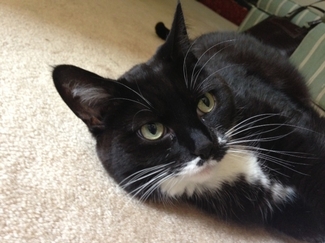Feline acne can plague your cat, but one simple change can eliminate the condition

Lorrie Shaw | Contributor
One problem that cats can have that they can't hide — feline acne — is one that needs a proper diagnosis by a clinician and could even be avoided altogether with one simple change in their daily schedule.
Chin acne in cats? Yes.
It manifests as seemingly benign bumps — yes, blackheads — on the chin, to noticeably inflamed pustules. In the latter case, these can be especially itchy, painful and stubborn to treat. Hair loss may accompany the condition.
It's important to have it diagnosed properly by your veterinarian so that prompt treatment can be started. You will want to have other possible causes of other skin issues ruled out, like a fungal and bacterial infection, fleas, mites — and to assess general overall health. A suppressed immune system can be indicated by changes in the skin. Stress, poor grooming, abnormal sebum (skin oil) production or contact sensitivity/dermatitis can also be causes of feline acne.
Once feline acne has been established as a cause of the the symptoms, a treatment plan can be put in place to get it under control, as a stubborn secondary infection can set in. Your vet may prescribe a course of antibiotics (oral or topical) or a corticosteroid to reign in any accompanying inflammation.
An at-home regimen may be recommended, like warm water or tea compresses to soothe the area or an over-the-counter wash like chlorhexidine to cleanse the area daily.
Your vet may prescribe a clinical-strength cleanser to reduce the amount of bacteria in the chin area — a common contributor to feline acne.
Bacterial exposure commonly seems to stem from one source: the dish that an affected cat dines from.
Plastic dishes have been long-thought to be the culprit, because of their porous nature: they trap bacteria easily, and as your pet eats and their chin touches the dish, bacteria is transferred.
An easy remedy to this is to switch to wide-mouthed, ceramic, glass or stainless steel dishes, and to wash them well and often, no matter if you feed wet food or kibble.
Click here to read more on feline acne.
Lorrie Shaw leads the pets section for AnnArbor.com and owner of Professional Pet Sitting. Shoot her an email, contact her at 734-904-7279 or follow her adventures on Twitter.


Comments
JMA2Y
Mon, Aug 26, 2013 : 10:18 p.m.
We use Duoxo pads which come from the vet or can be ordered from Amazon (Duoxo has other products as well.) They are antiseptic pads and are useful for acne, cuts, scratches, even on skin where there's minor hair loss caused by the cat scratching. It has solved all of the problems.
Mousedeva
Wed, Aug 21, 2013 : 1:46 p.m.
Cool, thanks! I just heard about kitty acne for the first time this year. My boy gets it periodically - a big red bubble on his chin.
Technojunkie
Wed, Aug 21, 2013 : 12:13 p.m.
A raw meat diet should help too.
Sarah Rigg
Tue, Aug 20, 2013 : 7:54 p.m.
We switched recently because of concerns about this. I bought 8 identical porcelain bowls at the Dollar Store and run them through the dishwasher at least every-other day now, though I admit I'm a bit less faithful cleaning the water bowls that often.
JuliaAnnArb
Tue, Aug 20, 2013 : 4:27 p.m.
Changing the bowl and keeping it clean sure seems easier than applying a warm tea compress! YCMV (Your cat may vary)